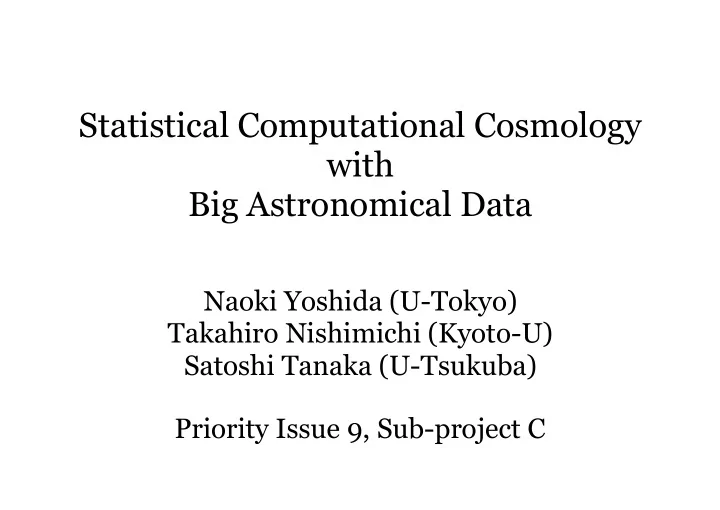

Statistical Computational Cosmology with Big Astronomical Data Naoki Yoshida (U-Tokyo) Takahiro Nishimichi (Kyoto-U) Satoshi Tanaka (U-Tsukuba) Priority Issue 9, Sub-project C
"Evolution" of cosmological sims 13 10 DEUS; N Ishiyama, Makino 11 Horizon Number of particles 10 Millennium simulation simulation 9 10 Hubble Volume; Bode, Ostriker Y.P.Jing 7 10 Gelb & Bertschinger Suginohara, 5 10 Suto, Bouchet, Hernquist Davis, Efstathiou, Frenk, White 3 10 Aarseth, Gott, Turner Peebles, Miyoshi & Kihara 1970 1980 1990 2000 2010
Extraction Summary statistics MCMC Sampler M Extraction Summary statistics M M Observational data Observational data COSMOLOGICAL ANALYSIS MODEL Conventional strategy Our new approach Bayesian Prediction inference (analytical model) prediction (Bayes) Performance Bayesian tests inference Simulation Emulator
σ 8 DARK QUEST: SIMULATION DESIGN • Curse of dimensionality (input = 6D) Regular lattice is not tractable in high dimensions • • Latin Hypercube Designs (LHDs) Each sample point is the only one both on the row • and on the column Uniform sampling when projected onto any one axis • Ω m • LHD is not unique and not always efficient Our final design One more to add: space filling property: • 5-Slice LHD “the closest neighbor should be far" 100 points in 6D • A variant useful for ML problems 2-Slice LHD Possible LHDs Diagonal l a m i t p O m o d n a R
HYBRID FORWARD MODELING DESIGN • Requirements • Accuracy: a few percent level • Speed: seconds / evaluation (e.g., 2 days / simulation) • Flexibility: capture unknown effects in galaxy-matter connection • Our solution: Dark Emulator (= Simulations + Statistics) • Network based on analytical relations • Dimension reduction: Principal Component Analysis • Core: Gaussian Process Regression D Q I. PCA coeffs. PCA coeffs. PCA coeffs. Linear Modules Analytical calculation Basic quantities Linear mass variance Linear RMS displacement Linear matter power spectrum Abundance Module Clustering Modules PCA coeffs. PCA coeffs. Predictions by simulations PCA coeffs. Sheth-Tormen (Small scale) PCA coeffs. Propagators type form Halo Mass Function Large scale correlation signals (Small scale) Galaxy-Halo Connection Module Halo-mass cross CF Halo auto CF HOD Off-centering of centrals Our recipe to connect the Satellite radial profile Extra Features Modules Galaxy Modules Projected Statistics Modules simulation world to the reality Baryonic effects Galaxy-mass cross CF Galaxy-galaxy lensing profile Observables Galaxy auto CF Redshift-space distortions Galaxy projected CF
CROSS VALIDATION STUDY EXAMPLE Abundance of structures (80 training, 20 validation) Accuracy guaranteed Mass of dark matter halos [h -1 M solar ] (vs model by Tinker et al. 08’) Accuracy : better than 3% for the relevant statistics vs. ~10 - 15% from existing best models Mass of dark matter halos [h -1 M solar ]
A NOVEL APPROACH IN A SIX-DIMENSIONAL PHASE-SPACE
Physics and math of a self-gravitating system Collisionless N -body simulations closely follow the derivation of the collisionless Boltzmann equation, but do not directly solve It'd be nice if the evolution of f ( x, y, z, u, v, w ) is directly followed in 6D phase-space.
Neutrino Distribution color : neutrino overdensity contour: CDM overdensity black circle: DM halo with M>10 11 solar mass
Cross correlation of CDM and neutrinos θ CDM rest frame Excess of cross-correlation in the down stream side of relative velocity due to neutrino wakes
Probing the neutrino mass with cross-correlation r [ h -1 cMpc] r [ h -1 cMpc]
SUMMARY Wide-field sky survey probes a large volume of our universe Numerical simulations play a vital role in determining cosmology There are a variety of new approaches to reveal cosmic structure formation
Recommend
More recommend